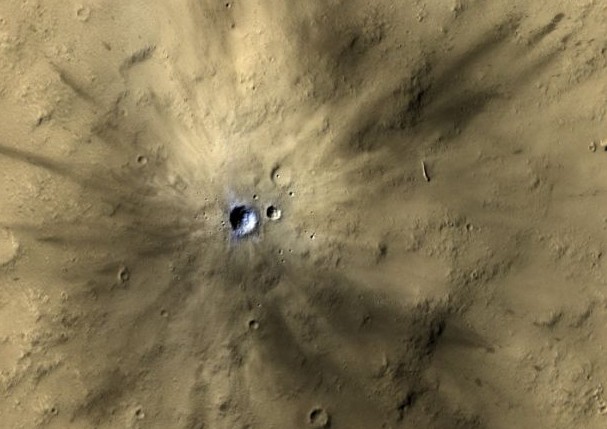Using images from NASA’s Mars Reconnaissance Orbiter (MRO) scientists have estimated that the planet Mars is bombarded by more than 200 space rocks – small asteroids or bits of comets – per year that form craters at least 12.8 feet (3.9 meters) across.
That might seem like a lot, but earlier estimates pegged the cratering rate at three to 10 times more craters per year.
Mars gets blasted with space rocks much more frequently than Earth because they are less likely to burn up in its thinner atmosphere.

These asteroids or comet fragments typically are no more than three to six feet (one to two meters) in diameter. Space rocks this size are too small to reach the ground here on Earth. But Mars has a much thinner atmosphere than our planet.
The 200-per-year planetwide estimate is a calculation based on the number of craters found in a systematic survey of a portion of the planet. The University of Arizona’s High Resolution Imaging Science Experiment, or HiRISE camera, took pictures of fresh craters at sites where before and after images had been taken.
HiRISE targeted places where dark spots had appeared during the time between images taken by previous camera. The new estimate of cratering rate is based on a portion of the 248 new craters detected. It comes from a systematic check of a dusty fraction of the planet with since late 2006. The impacts disturb the dust, creating noticeable blast zones. In this part of the research, 44 fresh impact sites were identified.
The meteor over Chelyabinsk, Russia, in February 2013 was about 10 times bigger than the objects that dug the the fresh Martian craters.

The researchers calculated a rate for how frequently new craters at least 12.8 feet (3.9 meters) in diameter are created. The rate is equivalent to an average of one each year on each area of the Martian surface roughly the size of Texas. Earlier estimates pegged the cratering rate at three to 10 times more craters per year. They were based on studies of craters on the moon and the ages of lunar rocks collected during NASA’s Apollo missions in the late 1960s and early 1970s. UA’s HiRISE Principal Investigator Alfred McEwen ia a co-author on the paper. He said:
Mars now has the best-known current rate of cratering in the solar system.
Estimates of the rate at which new craters appear serve as scientists’ best yardstick for estimating the ages of exposed landscape surfaces on Mars and other worlds.
Bottom line: Using images from NASA’s Mars Reconnaissance Orbiter, researchers from University of Arizona have estimated that Mars is bombarded by more than 200 space rocks – small asteroids or bits of comets – per year that form craters at least 12.8 feet (3.9 meters) across. Earlier estimates pegged the cratering rate at three to 10 times more craters per year.











